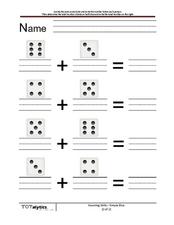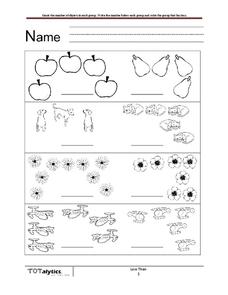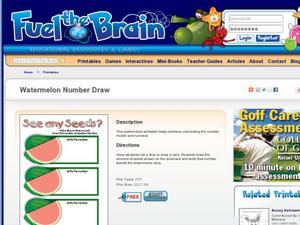Curated OER
Addition Practice
Give your mathematicians a leg up on simple addition using this activity with visual aids. Similar to counting cubes, each single-digit addend is accompanied by a corresponding number of colored squares. The two colors are joined where...
Curated OER
Fill the Frame
How long does it take to fill a ten frame? Partners practice counting as they play this math game- and all you need are counters! Pairs use one die, rolling one at a time. For each roll, they add that many counters to their ten frame....
Curated OER
How Many? Counting to Five
For this counting to five worksheet, students learn about the number five. They trace the word five and practice counting five balls.
Curated OER
Counting Triangles
Help your little learners recognize number words one through ten. Each slide contains a triangle with a number word inside of it. As the slides progress, more triangles appear in successive order 1-10. This is a great way to reinforce...
Curated OER
Counting on Cup
A basic approach to counting on, this math game has beginners partner up and use number cards and dice as they practice beginning addition. One partner chooses a number card and counts that many objects into a cup. The second partner...
Curated OER
Counting Cup
Use a counting cup or bag to complete this activity, which has young counters examining the contents of their container. Once they dump it out, they count and record the number either using words, pictures, or numbers. Try a mix of all...
Curated OER
Number Patterns
An easy way to introduce numerical patterns, these activities can be made simpler by using addition, or more difficult with division, fractions, and percentages. Children examine patterns and determine the missing number in the sequence....
Curated OER
Let's Learn About Money
Rather than breaking their piggy banks, your students can use this worksheet to demonstrate their understanding of the fixed value of coins. Class members add the values of pennies, nickels, dimes, and quarters to determine the total...
Curated OER
Show That Number
Kindergarteners draw dominoes to match a number of objects to a given number. Numbers 1-5 are listed and illustrated with a domino. Young counters then draw the correct number of tiles and include the correct number of dots on each tile.
Curated OER
Bunnie Education: 1-10 Worksheet
For this elementary math worksheet, 1st graders practice adding simple numbers in order to practice counting up to the value of ten. This is done in ten problems.
Curated OER
Numbers and Operations
In this counting worksheet, students count the fruit on each of the trees and then write the sum. Students complete 4 problems total.
Curated OER
Count the Dice
Use a familiar image to help beginning mathematicians with basic addition. Using dice rolls from 1-6, learners indicate the number shown on each die, then add each pair to get a total. The advantage is that they can count the dots if...
Curated OER
Counting Objects
What an easy way to practice counting and comparing numbers! Learners examine four sets of drawings, each with two types of objects pictured. They count each object, writing the number below. Then, they color in the item with fewer...
Curated OER
Mystery Jars: Make Your Own
There are many ways to implement this estimation and counting activity. Young mathematicians fill jars with objects to create "mystery jars." Add difficulty by using smaller objects. After counting, learners secretly record their exact...
Curated OER
Count the Dots on Each Die
Kindergarteners use the dice reproduced on this worksheet to demonstrate their understanding of concepts of addition and missing numbers. After counting the dots on each die, young mathematicians write the number below each picture. They...
Curated OER
See any Seeds?
Oh no! These watermelons have no seeds! Beginning counters use fun templates as they roll dice and draw the resulting number of seeds onto the watermelon image. They also write the number in the space beside the watermelon. Consider...
Math Salamanders Ltd.
Place Value - Hundreds, Tens, and Ones - Count the Balloons
Second graders count the number of balloons represented in groups of hundreds, tens, and ones, then compose a three-digit number. There are three problems to solve.
Curated OER
Counting in Tens, Beginning with 70
Mr. Mouse instructs kids to fill in the blanks by counting 10's. They skip count by 10s to finish each of the 6 number lines. Learners will count by 10 beginning at 70, 100, 90, 50, 140, and 260.
Curated OER
Reading and Writing Numbers up to Thousands
Budding math analyists look at 4-digit numbers that are broken down by thousands, hundreds, tens and units. They write each number in words and represent them using their unifix cubes of base 10 blocks. There are two problems to complete...
Curated OER
Adding By 4's
Why is skip counting important? By practicing skip counting, learners will be able to solve problems quicker. With this fill-in-the-blank worksheet, elementary math learners will practice counting by four.
Curated OER
Early Mental Math: Practice
Pupils start from a given number and count forward by 1s, 2s, and 10s. They "make ten" in 4 addition problems, and add or subtract 2 in the rest. Finally, they circle the odd numbers in a list from 1-14.
Curated OER
Add Tens
Learners solve six story problems about adding 10s. Provide 10-rods or objects they can group into 10s to visualize what is being asked. Two of the problems provide irrelevant information; with discussion and guidance, this is also a...
Curated OER
Teen Numbers
Reinforce that numbers in the teens are 10 plus more with this learning exercise of 6 practice problems. Children count and circle a group of 10 objects. Then they count on the extras and write the total number in a box. Some sets have...
Curated OER
Count the Dots: 10 Plus More Makes 11-20
Young math learners count and circle a group of 10 dots. They count on the extras, and write the corresponding number between 11 and 20 in a box. Nine practice problems in all.

























